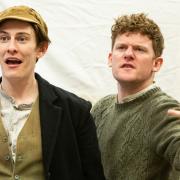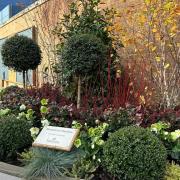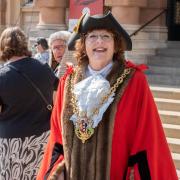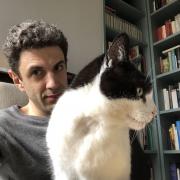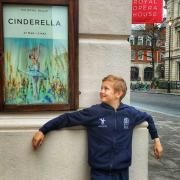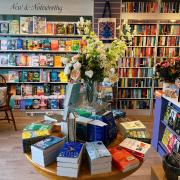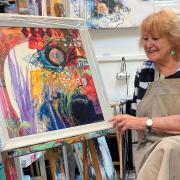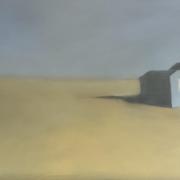Nick Champion describes how they are reviving the spirit of Christmas Past at the National Trust's Tranmer House
Nick Champion describes how they are reviving the spirit of Christmas Past at the National Trust’s Tranmer House
When you think of Sutton Hoo you tend to think of Anglo-Saxon treasure, an iconic helmet and mysterious mounds concealing the rich burial treasures of East Anglian kings. You may also think of breathtaking views across the Deben estuary towards Woodbridge. But would you normally associate Sutton Hoo with paper chains, home-made Christmas tree decorations and the sound of voices lifting up in song?Following the successful opening of Tranmer house in June this year, the Sutton Hoo team of staff and volunteers are opening their doors and inviting you in to mark the festive season as it was celebrated over 70 years ago.Christmas in 1939 was very different from those which had gone before. War in Europe was only a few months old, many men had registered for National Service but had yet to be called up, few bombs had been dropped on the British mainland and the British Expeditionary Force was experiencing the anticipation and boredom of the Phoney War or ‘Sitzkrieg’ as some called it.More than a million children were evacuated from cities to the countryside and every man, woman and child was required to carry a gas mask. Sandbags were piled around doors and windows of shops and public buildings, and a blackout introduced which included street lighting and car headlights. This immediately caused a threefold rise in crashes. By December, barrage balloons floating above cities to deter enemy bombers were a common sight. One newspaper reported that the impact of the blackout meant a return to old-fashioned pleasures, with “many firesides where the family groups itself as it has not done since Victorian days.” The London correspondent for the New Yorker magazine wrote: “This is by a long shot the queerest Christmas anyone remembers.” As Christmas approached the British public seemed at a loss as to how to spend their first wartime Christmas. Would it be unseemly to carry on as usual? Or was it their patriotic duty to make this a happy Christmas and New Year break, in defiance of Hitler? The Lady magazine had no doubt about how to respond. Rather than leaving ‘the ghost of old Father Christmas moping at the door’, it advised its readers to “cut a bright square out of the winter of our discontent and keep Christmas for the children’s sake.” It added optimistically that: “Shorn of the waste, the gluttony, the excessive clannishness which began to grow over it during the prosperous generations, Christmas may be merrier than ever in the true sense of the word.” Taking such guidance to heart, some families decided to indulge themselves while they still could. Rationing had not yet been enforced (except for petrol), but the government had announced it would begin in the new year, starting with bacon and butter. The winter of 1939 was a cold one; carol singers willing to brave the frost were ordered to keep their lights pointed downwards so as not to break the blackout. Church services were held as normal, but bells were not rung in case they were taken as an invasion warning. At 3pm on Christmas Day, King George VI broadcast his Christmas message from Sandringham. “A New Year is at hand,” he said. “We cannot tell what it will bring. If it brings peace, how thankful we shall all be. If it brings us continued struggle, we shall remain undaunted.” The broadcast was deemed so successful and uplifting that it became an annual event. Bearing in mind that the average semi-detached house cost �400 in 1939 while a Ford family car cost �130, it is scary to think that on average last year, each person spent �500 on Christmas.Elizabeth Rohde, visitor services manager at Sutton Hoo, is trying to evoke that time when the true spirit of Christmas meant bringing family together to make the most of the season while they still could.“Christmas in 1939 must have been a strange one – all the uncertainty of war whilst wanting to try to keep things as they had always been. I’d like every visitor who walks through the doors of Tranmer House to feel connected with that time in our past. Despite the clouds gathering over Britain, people still tried to feel festive and Christmassy and that’s the atmosphere we are trying to get across in Tranmer house.”Formerly known as Sutton House, Tranmer House was built in 1910 as a statement of wealth and influence. It was kindly gifted, unfurnished, to the National Trust by trustees of the Annie Tranmer Trust in 1998, hence the name change. The House was designed by John Corder, an architect from Ipswich, and built by John Chadwick Lomax. Edith Pretty bought the house for �15,250 after her marriage to Lt Colonel Frank Pretty, the son of a successful draper and store owner. Edith’s father, a multi-millionaire owner of an engineering company, thought Frank Pretty, whose family were “in ladies’ underwear”, below his daughter. Even though the couple met and fell in love when Edith was 17, they were not able to marry until Edith’s father died when she was 43.“Mrs Pretty was a very sociable person,” says Elizabeth. “She was heavily involved in the local community and very outward looking. We have worked hard to try to present the house as she may have done, with festive wreaths, paper chains and a big Christmas tree covered with decorations – some of them handed down through the family and some of them home-made as part of the traditional run up to Christmas.”The official opening of Tranmer House to the public took place in June with a furnished house in a style which Mrs Pretty herself would have enjoyed. There’s even an Edwardian sideboard that once belonged to WWI fighter pilot Albert Ball. “We have been thrilled with the reaction from visitors,” says Elizabeth. “They say it feels exactly like a family home. I’ve even found people asleep in the chairs!“One of my favourite things about Christmas for me is the carol services and we couldn’t have Christmas here without music. We have local choirs who will be singing carols from the period – nothing after 1939.“What I’m really excited about is that every visitor will be met and greeted by a servant who will look after them. They’ll also receive a complimentary glass of mulled wine and a mince pie.”
Visit www.nationaltrust.org.uk/suttonhoo or call 01394 389700 for more information.





